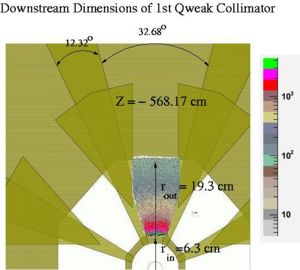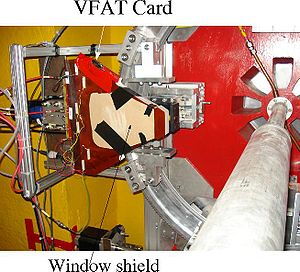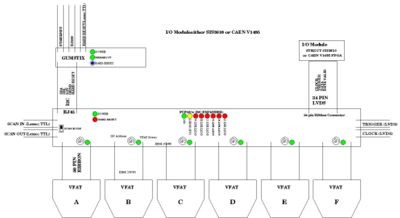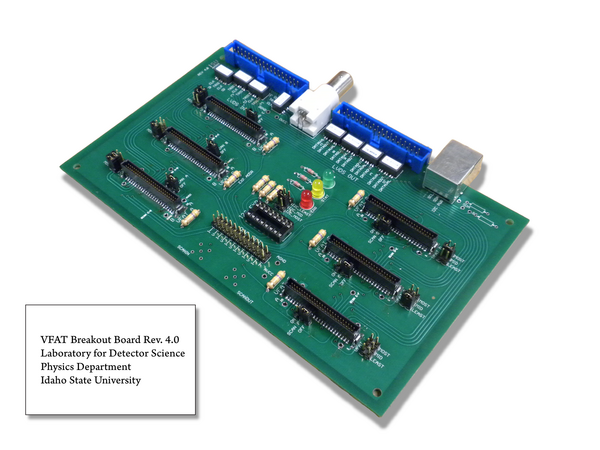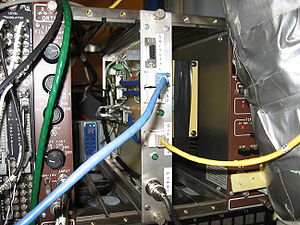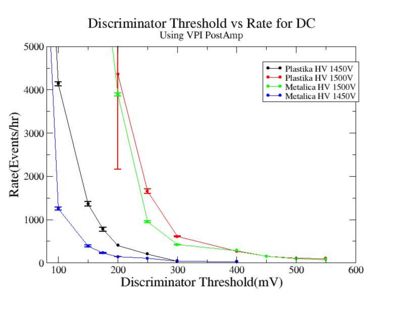Difference between revisions of "ForestNSFInterimReport 8-31-10"
| Line 56: | Line 56: | ||
== What have been your major research and education activities (experiments, observations, simulations,presentations, etc.)== | == What have been your major research and education activities (experiments, observations, simulations,presentations, etc.)== | ||
| − | The nuclear physics group at Idaho State University has been actively engaged in three experiments at Jefferson Lab, Qweak, Primex, and g13. PI Forest and graduate students T. Diberidze and W. Parsons have worked on installing the R1 tracking detector and readout electronics for Qweak. PI Dale, has worked to published the latest results from the Primex experiment and is currently preparing to take data in Jefferson Lab's Hall B. PI Cole and graduate students D. Martinez, J. Salamanca and C. Taylor have been working on the | + | The nuclear physics group at Idaho State University has been actively engaged in three experiments at Jefferson Lab, Qweak, Primex, and g13. PI Forest and graduate students T. Diberidze and W. Parsons have worked on installing the R1 tracking detector and readout electronics for Qweak. PI Dale, has worked to published the latest results from the Primex experiment and is currently preparing to take data in Jefferson Lab's Hall B. PI Cole and graduate students D. Martinez, J. Salamanca and C. Taylor have been working on the g13 data set taken in JLab's Hall B. Two students, W. parsons and J. Salamanca, have graduated this year. |
Revision as of 03:39, 31 August 2010
From Dan:
The group's activities in regards to the {\em PrimEx} experiment at
Jefferson Laboratory have focussed on writing publications resulting from
the last run as well as preparing for the upcoming run at Jefferson Laboratory which is
scheduled to run from September 27, 2010 to November 10, 2010.
The {\em PrimEx} Collaboration is in the final stages of editing a paper to be submitted to Physical Review Letters in the next couple of weeks. In this paper, we report a radiative neutral pion decay width, $\Gamma(\pi^o\rightarrow \gamma \gamma)$ of $7.82 \pm 0.14 (stat) \pm (0.17) (syst) eV$. This result is considerably more precise than the current Particle Data Book average (2.5 times more precise), and is consistent with current chiral perturbation calculations including next-to-leading order. In addition to this paper, substantial progress has been made on a paper describing high precision photon flux measurements for tagged photon experiments. Publication of this paper is expected during year two of this grant.
For the upcoming {\em PrimEx} run, the ISU group has taken primary responsibility for the pair spectrometer online luminosity monitor. During this period, considerable work was performed on the pair spectrometer including electronics checkout, upgrading and calibrating the scintillator detectors, and development of the run plan as it impacts the luminosity monitoring. As spokesperson for the experiment, Dr. Dale has also written the relevant safety documentation for the experiment which is required by the Laboratory, and has been involved in the preparation for the run at all levels.
ARRA reports
000416256
7/14/10
ARRA funding has supported the activities of 5 personnel working to fulfill the research objectives outlined in NSF award #PHY-0855661. The objectives of the last quarter, as described in the above proposal, were to complete installation of the Qweak detectors in Hall C at Jefferson Lab and begin the construction of the R1 chambers for Hall B. The Qweak detectors for Jlab's Hall C have been delivered and one of the detectors is currently operating in the Hall. The mounting system for the detectors was the responsibility of another institution and has faced some challenges delaying it's completion. T. Didberidze and principal investigator, T. Forest, have made two trips to JLab to complete the installation and plan at least one final trip at the end of July. The construction of the R1 drift chambers for Hall B has been delayed by Hall B management for about 8 months. B. Starks has been designing several clean room options to facilitate the construction of the R1 chambers during the past quarter and will finalize the design by the end of July. C. Taylor used his calibration work on g13 to calibrate the start counter for the FROST experiment at Jlab as a collaborative service task. D. Martinez is has completed calibrating the time-of-flight system for the g13 experiment and is now using that calibration to search for mesons to analyze for his thesis. W. Parsons defended his thesis on the Qweak readout system and is currently completing thesis revisions. J. Salamanca has graduated since the last quarter and taken a position at another institution.
1/14/10
ARRA funding has supported the activities of 6 personnel working to fulfill the research objectives outlined in NSF award #PHY-0855661. The objectives of the last quarter, as described in the proposal, were to complete testing of the Qweak region 1 tracking system and begin installing a clean room. T. Didberidze has completed testing the Qweak region 1 detector and has shipped one of the two detectors to JLab. B. Starks has received two air shower enclosures for the clean room and has installed a temperature monitoring system. W. Parsons has completed a software library which will be used in a readout system for the Qweak detector. J. Salamanca has graduated with a Ph. D. in physics and will be starting an academic position in Colombia. D. Martinez is calibrating a time-of-flight system for the g13 experiment in JLab's hall B. C. Taylor is calibrating the Large Angle Calorimeter for the g13 experiment in JLab's Hall B.
Participants
Tony Forest Principal Investigator Yes Phil Cole Principal Investigator No Dan Dale Principal Investigator No Tamar Didberidze Graduate student Yes Warren Parsons Graduate student No Berkley Starks Graduate student No Danny Martinez Graduate student No Julian Salamanca Graduate student No Cuck Taylor Graduate student No
Activities and Findings
This section will serve as your report to your program officer of your project's activities and findings. Please describe what you have done and what you have learned, broken down into four categories:
What have been your major research and education activities (experiments, observations, simulations,presentations, etc.)
The nuclear physics group at Idaho State University has been actively engaged in three experiments at Jefferson Lab, Qweak, Primex, and g13. PI Forest and graduate students T. Diberidze and W. Parsons have worked on installing the R1 tracking detector and readout electronics for Qweak. PI Dale, has worked to published the latest results from the Primex experiment and is currently preparing to take data in Jefferson Lab's Hall B. PI Cole and graduate students D. Martinez, J. Salamanca and C. Taylor have been working on the g13 data set taken in JLab's Hall B. Two students, W. parsons and J. Salamanca, have graduated this year.
The construction of the Region 1 tracking system for the Qweak experiment has been the main research focus of the support from this proposal. The Qweak experiment is scheduled to measure the parity violating elastic scattering of polarized electrons from protons at Jefferson Lab. The measurement will be used to extract the weak mixing angle and thereby test the standard model. The PI for this award is responsible for the design and construction of the Region 1 detector system. Other activities also undertaken include the testing of prototype drift chambers for the Hall-B 12 GeV upgrade and an analysis of experimental data which will lead towards the extraction of nucleon polarized structure functions. The progress of these endeavors is described below.
Qweak Region 1 Tracking System Detector Construction
The testing and installation of the Region 1 tracking system for the Qweak experiment at Jefferson Lab has been the main research activity supported by this grant. The Qweak Region 1 tracking system is one of three tracking systems designed to measure the profile of elastically scattered electrons as well as background contributions to the parity violating signal. The Region 1 tracking system is located behind the first collimator at a distance of about 550 cm from the main torus magnet ( 200 cm from the target). The collimator divides the acceptance into 8 regions, octants, and reduces the azimuthal acceptance by almost 30 percent. Figure 1a shows the elastic scattering profile overlayed on top of one of the octants. Figure 1b shows the detector mounted on the R1 rotator in preparation for a few tests. One VFAT card is mounted to the top of the detector so the impact of the high dose can be tested before installing all of the readout cards. The Region 1 tracking system will measure the electron scattering angle at only 2 of the octants at a time and will rotate in to perform measurements in the remaining octants.
A front end readout system which may be used for Qweak's region 1 tracking system has been under development for the last 3 years. It is based upon a digitization card, known as the VFAT hybrid board, designed at CERN for the TOTEM experiment. The VFAT board has been designed to withstand up to 100 Mrad of radiation and can digitize it's 128 input channels at a sampling frequency of 40 MHz storing up to 128 triggered events. The VFAT card digitizes the analog output of the GEM detector to indicate the presence of a hit on one of the charge collector's copper strips.
The infrastructure to readout a detector contains four basic elements. A VFAT readout board to convert the analog charge observed on a charge collector strip to a digital signal. A Gumstick unix micro-controller to program the VFAT card and set parameters like the amplifier gain and discriminator the thresholds. A breakout board which serves as a branch highway to deliver control input and data output signals. A VME I/O board, CAEN V1495, to receive the LVDS digital signals from the VFAT via the breakout board and store the signals for readout by a single board computer located in a VME crate.
Implementation of the breakout board and the programming of the CAEN V1495 FPGA were the subject of W. Parson's graduate thesis. The lines of communication between the VFAT readout board, the Gumstick controller, and the VME FPGA I/O module are managed by the breakout board. W. parson's thesis describes the design of this board. The design and a picture of the finished board are shown below in Fugure2. The thesis also designs the programs developed for the V1495. Also shown in the Figures is a NIM module design by T. Didberidze which is used to distribute power and the I2C micro-controller signals to the readout system.
Physics Analysis
Graduate students T. Didberidze, C. Taylor, and D. Martinez are analyzing Jefferson Lab data sets taken in Hall B. T. Didberidze is currently analyzing data fron Hall B's EG1 run group which will test independent fragmentation for SIDIS. have While the construction and testing of ionization chambers for Qweak is a valuable graduate student hardware experience, the graduate student supported by this grant will need to write a thesis on a research physics topic. Due to the time constraints involved, Tamar Didberidze, has been doing her physics research on data that has already been taken. C. Taylor used his calibration work on g13 to calibrate the start counter for the FROST experiment at Jlab as a collaborative service task. D. Martinez is has completed calibrating the time-of-flight system for the g13 experiment and is now using that calibration to search for mesons to analyze for his thesis.
What are your major findings from the activities identified above
During the past year there are three findings which should be reported. The first finding was the proof in principle of a candidate readout system for the Qweak experiment. The second finding is a comparison between an analysis currently underway by the graduate student on this grant with a previous experiment. The third finding was a serendipitous result involving experimentation with a drift chamber system under study.
Qweak readout Speed tests
The VFAT is a candidate front end readout card for Qweak's region 1 tracking system. The VFAT chip has been designed to sample the detector analog output at 40 MHz. Although elastically scattered electrons which traverse the entire Qweak apparatus are expected to trigger the readout system at rates of about 1 kHz, there is a large background due to moller scattering which corresponds to rates of 12 MHz/nA uniformly distributed over the entire region 1 acceptance. The moller rate on a single detector strip would be about 25 kHz/nA. This restricts the region 1 tracking system to operating currents below 400 nA since the detector rise time of 50 nanoseconds will result in signal pileup if the ionization particle flux rates exceed 10 MHz. The VFAT board by itself can satisfy the readout requirements of Qweak.
The remaining question is whether the transfer of the VFAT digital output to the data acquisition system without introducing a bottleneck. The CERN engineer who designed the VFAT board suggested the use of a Field Programmable Gate Array (FPGA). THE VME 1495 FPGA I/O module from CAEN was selected for testing. We observed read and write speeds between the VME backplane and the FPGA user registers of 16 bits to USER FPGA in 330 ns. This measurement correspond to a throughput speed of 6 MB/sec compared to a requirement of 0.5 kb/sec for Qweak.
Drift Chamber Feedthroughs
As part of her graduate studies, Tamar Didberidze has been quantifying the performance of two proto-type drift chambers for Hall-B. The ionization chamber principle is similar to the GEM chambers being built for Qweak and was a good training experience for her until the Qweak chambers are completed. Two ionization chamber proto-types were built by JLab and sent to ISU. They are identical except that one uses an all plastic feedthrough to hold the drift chamber wires and another has a plastic feedthrough with a metal tip where the wire makes contact with the feedthrough. The proto-type detectors will be used to evaluate the efficency of the chamber as a function of the ionizating particles position from the end of the wire. A Garfield simulation leads one to believe that the plastic tipped feedthrough will result in a less efficent detector near the end of the wire due to a less radial electric field lines. The answer to this question will impact the design of drift chambers for the CLAS 12 upgrade. During this funding cycle, Tamar has discovered that the proto-type detector using plastic feedthroughs is noisier than the one which has metal tips.
What research and teaching skills and experience has the project helped provide to those who worked on the project
Describe the opportunities for training and development provided by your project.
As part of their graduate studies, Tamar Didberidze and Julian Slamanca, gained skills and experiences in the area of detector development. The design of a charge collector for the Qweak detector exposed them to modern circuit design software as well as some of the compatibility issues between software packages. The construction of ionization chambers using modern machinable plastics like Ertalyte exposed students to conventional machine shop practices and the use of a milling machine. The evaluation of prototype detectors gives students signal processing experience using both analog and digital devices. Both single cosmic events as well as coincidence events using multiple detectors such as scintillators and drift chambers is an on going experiment in our Laboratory for Detector Science. Students are exposed to and gain experience with NIM and VME based signal processing systems. Graduate students also gain teaching experience mentoring the undergraduates that have taken part in the projects described in the Activities section of this report.
What outreach activities have you undertaken to increase public understanding of, and participation in, science and technology?
Describe outreach activities your project has undertaken.
The physics department also holds a mentoring program for high school teachers and their students during the first month of summer. I instructed a group of about 20 teachers and student on the operating principles of drift chambers, scintillators, and solid state detectors. He-3 neutron detectors will be given to the science teachers for use at their home institution. As a result, the neutron detection principle of a He-3 detector was the main focus of the lecture. The He-3 detectors are from a completed experiment at PNNL laboratories and were made available to ISU due to its research partnership with PNNL Laboratories. The arrangement is a fortuitous example of how research and education can combine efforts and improve the public's understanding of science and technology.
Publications and Products
In this section, you will be asked to describe the tangible products coming out of your project. Specifically:
What have you published as a result of this work? Journal publications
Books or other non-periodical, one-time publications
What Web site or other Internet site have you created?
What other specific products (databases, physical collections, educational aids, software, instruments, or the like) have you developed?
What have you published as a result of this work?
This work is in progress and has not resulted in any publications.
Journal publications
- Deeply Virtual Compton Scattering Beam-Spin Asymmetries., F.X. Girod et al. (The CLAS Collaboration), Phys. Rev. Lett. 100, 162002 (2008). http://link.aps.org/abstract/PRL/v100/e162002
- Beam spin asymmetry in deep and exclusive p0 electroproduction., R. De Masi et al. (The CLAS Collaboration), Phys. Rev. C 77, 042201 (2008). http://link.aps.org/abstract/PRC/v77/e042201
- Cross Sections for gamma p to K0*+ Sigma at Egamma=1.7-3.0 GeV , I. Hleiqawi, et. al., Phys. Rev. C 75,2007, 042201.
- Separated Structure Functions for the Exclusive electroproduction of K+ Lambda and K+ Sigma Final States , P. Ambrozewicz, et. al., Phys. Rev. C 75,2007, 045203.
- First measurement of Beam Recoil Observables C(x) and C(z) in hyperon Photoproduction , R. Bradford, et. al., Phys. Rev. C 75,2007, 035205.
Quark-Hadron Duality in Spin Structure Functions g1p and g1d , P. Bosted, et. al., Phys. Rev. C 75,2007, 035203.
Books or other non-periodical, one-time publications
"An Accelerator Based Cargo Container Inspection System for Nuclear Materials", T. A. Forest, et. al., Eight International Topical Meeting on Nuclear Applications and Utilization of Accelerators, American Nuclear Society, pg 470, Aug. 2007
What Web site or other Internet site have you created?
Wiki
What other specific products (databases, physical collections, educational aids, software, instruments, or the like) have you developed?
Contributions
Now we invite you to explain ways in which your work, your findings, and specific products of your project are significant. Describe the unique contributions, major accomplishments, innovations and successes of your project relative to :
the principal discipline(s) of the project;
other disciplines of science or engineering;
the development of human resources;
the physical, institutional, or information resources that form the infrastructure for research and education; and
other aspects of public welfare beyond science and engineering, such as commercial technology, the economy, cost-efficient environmental protection, or solutions to social problems.
